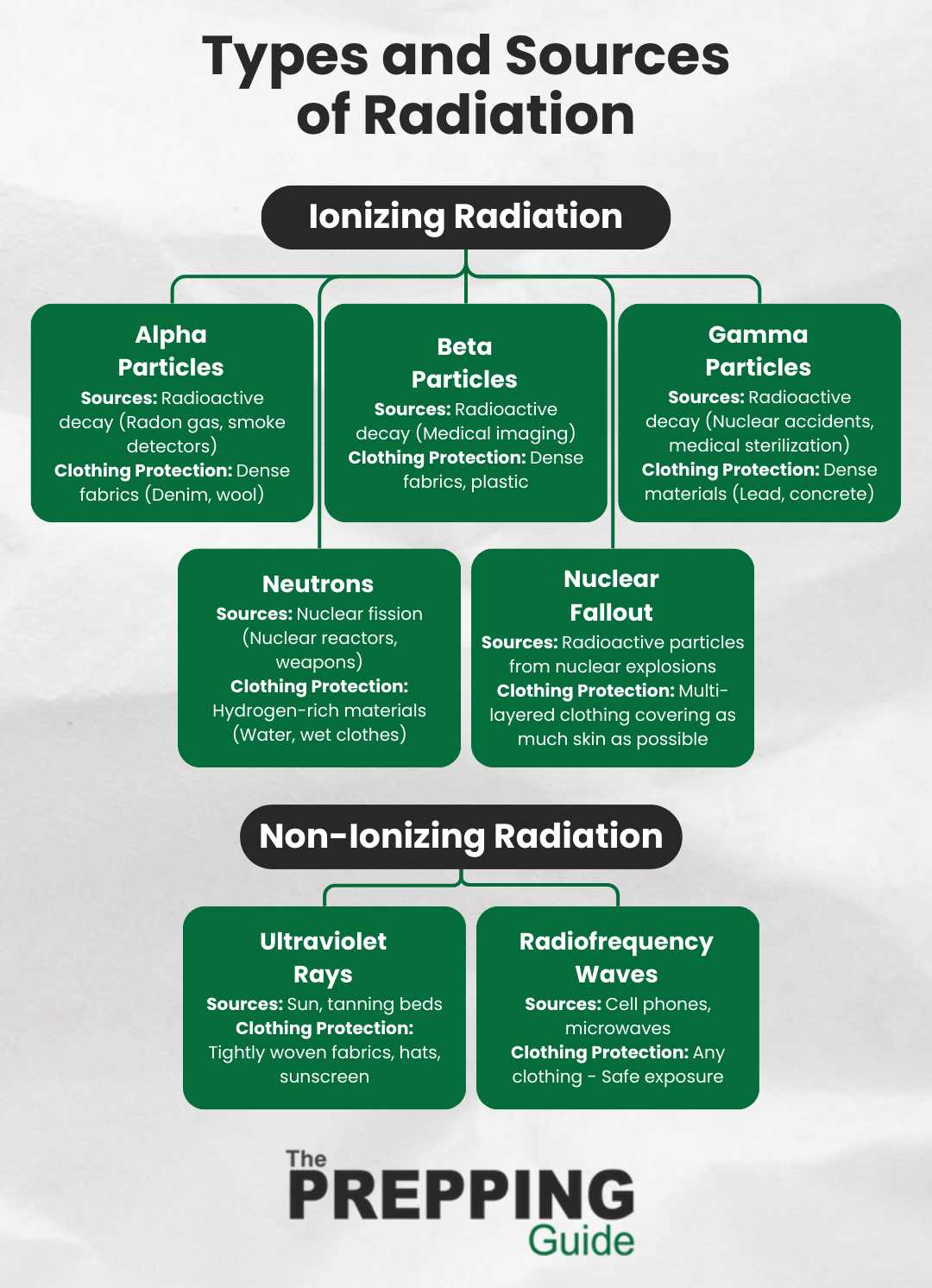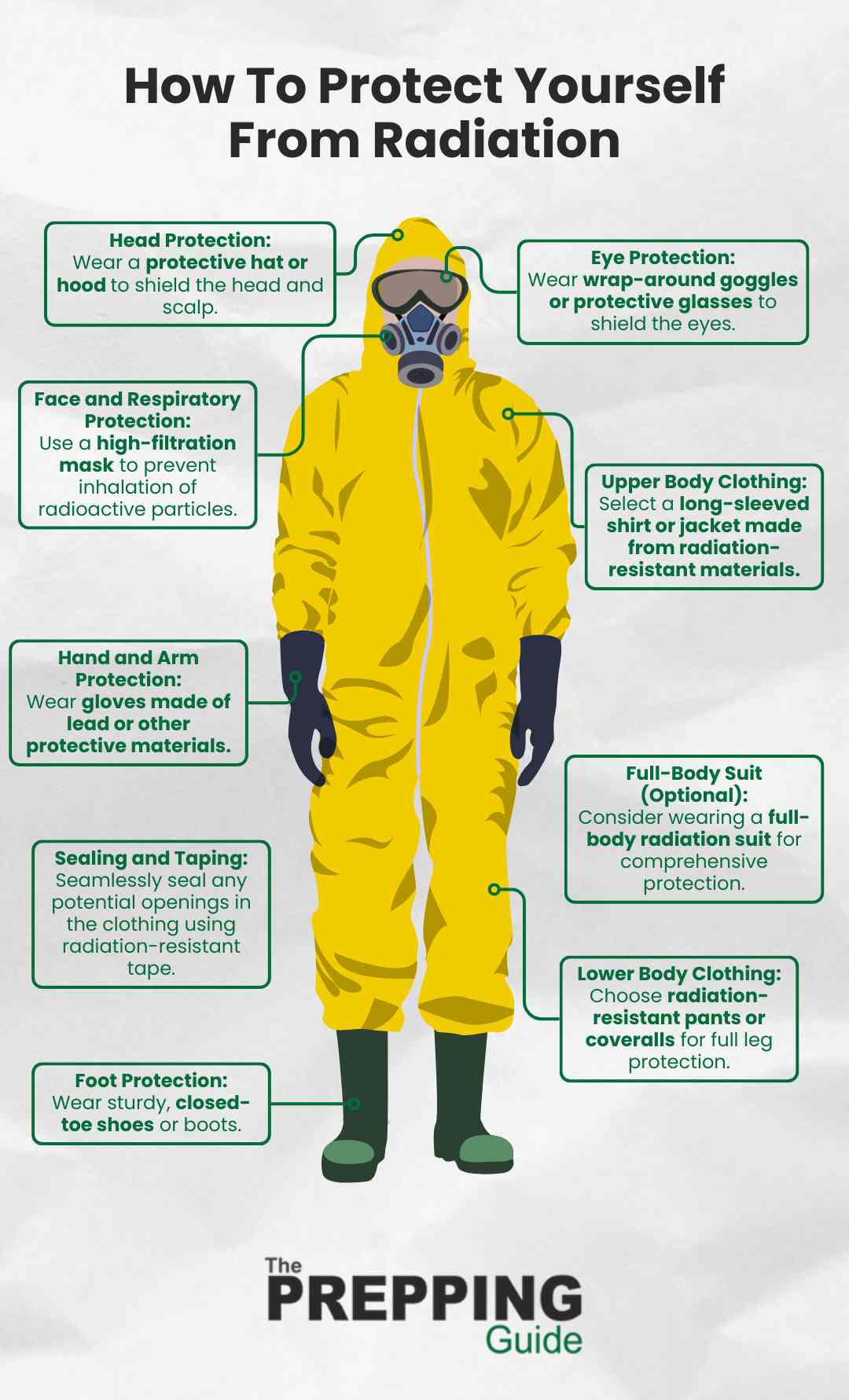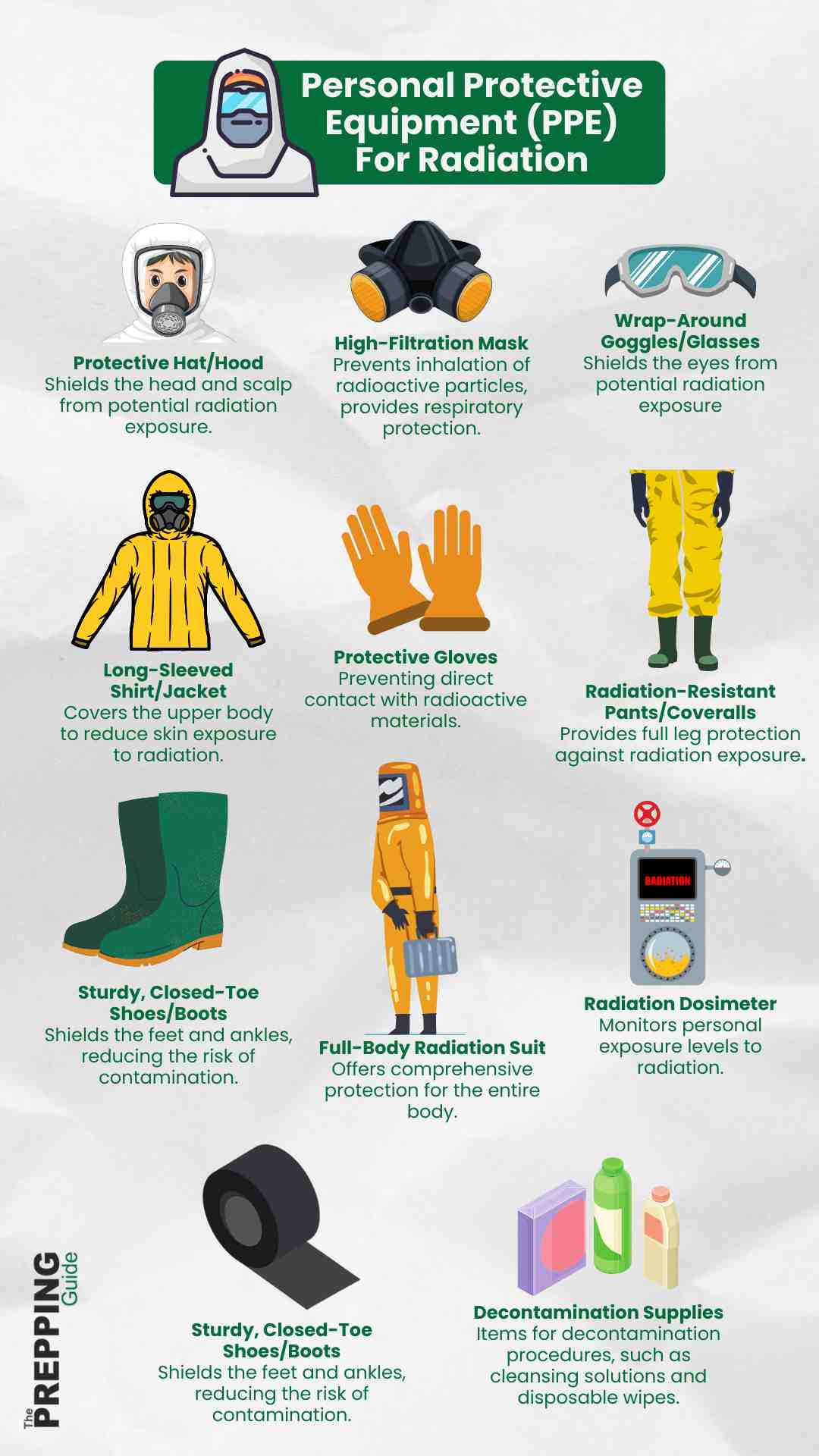While the idea of a mushroom cloud may sound like fiction, the danger of nuclear fallout is real. Even though considering such situations can be unsettling, being informed is crucial. Today, we are addressing a vital question: What should you wear to protect yourself from radiation in a nuclear war?
To protect yourself from radiation, it is crucial to wear specialized protective clothing designed for shielding against atomic particles. Opt for garments made from materials like lead or high-density fabrics, and remember to include a well-sealed mask and gloves.
In this article, you will discover the importance of adhering to radiation protection standards and learn about the garments designed to safeguard you from these harmful rays.
Understanding Radiation and Its Types
When it comes to understanding radiation and its types, there are a few key points you need to know.

Different Types of Radiation
“The primary radiation hazard from fallout after a nuclear detonation arises from external exposure to penetrating radiation released from the decaying radioactive particles, rather than from internal contamination (exposure) from breathing or ingesting radioactive material.”
–Radiation Emergency Medical Management (REMM)
Although radiation comes in various forms, each one poses its unique threat and should be taken seriously.
Different types of radiation include ionizing radiation, such as gamma rays and X-rays, which have enough energy to remove tightly bound electrons from atoms or molecules, causing damage to DNA and other cellular structures.
Conversely, non-ionizing radiation has lower energy levels and includes radio waves, microwaves, and visible light.
While non-ionizing radiation is generally considered safe at low levels of exposure, ionizing radiation can have harmful effects on the body.
Understanding the different types of radiation is crucial for ensuring radiation safety in various settings, such as medical procedures involving radiation therapy or occupational exposure.
Sources of Radiation
One must be cautious of the various sources that emit harmful radiation. Understanding these sources is crucial for minimizing radiation exposure and ensuring safety.
There are both natural and artificial sources of radiation. Natural sources include cosmic rays from space, radioactive materials in the Earth’s crust, and radon gas. Synthetic or man-made sources include nuclear power plants, X-ray machines, and radioactive materials used in medicine and industry.
Radiation effects can vary depending on the type of radiation and the dose received. High doses can cause immediate health effects such as burns or acute radiation sickness. Long-term exposure to lower doses may increase the risk of cancer or other diseases.
Potential Health Risks Associated with Radiation
Exposure to radiation poses various potential health risks, depending on factors such as the type of radiation, duration of exposure, and the individual’s proximity to the source.
Ionizing radiation, which includes sources like X-rays and nuclear materials, can have detrimental effects on human health.
One primary concern is the increased risk of cancer development. Ionizing radiation can damage DNA within cells, potentially leading to mutations that may initiate cancerous growth. Chronic exposure to low levels of radiation can elevate this risk over time.
Apart from cancer, radiation exposure can affect other bodily systems. Acute radiation syndrome (ARS) may occur in the aftermath of high-dose radiation exposure, leading to symptoms such as nausea, vomiting, diarrhea, and even damage to organs like the heart and lungs.
Radiation Protection Standards
When it comes to radiation protection, you need to adhere to regulatory guidelines that ensure your safety. These guidelines outline the maximum permissible dose of radiation exposure and provide instructions on minimizing risks.

Regulatory Guidelines for Radiation Protection
Radiation protection is governed by various regulatory guidelines and standards established by national and international organizations to ensure the safe use of radiation and minimize potential health risks. These guidelines cover a range of areas, including medical procedures, occupational exposure, environmental considerations, and public safety.
The International Commission on Radiological Protection (ICRP) recommends radiation protection and dose limits. Their guidelines are globally recognized and influence national regulations. They emphasize the principle of justification, which means that the overall societal benefits should justify any radiation exposure and be outweighed by the potential risks.
In the United States, the EPA establishes regulations for environmental radiation protection, ensuring the safety of air, water, and soil from radiation sources. These regulatory guidelines focus on dose limits, safety practices, monitoring, and optimizing radiation use to ensure that exposure is kept as low as reasonably achievable (ALARA) while balancing the benefits of radiation applications.
Industry-Specific Standards for Protective Clothing
When safeguarding yourself from radiation exposure, wearing appropriate protective gear is crucial.
The industry has developed specific requirements for such gear to ensure maximum safety. Fabric technology is vital in designing clothing that can effectively shield against harmful radiation.
The choice of materials and their construction are carefully considered to minimize the penetration of radiation particles. Innovative fabric technologies are constantly being explored and utilized to enhance the protective capabilities of these garments.
Additionally, clothing design is optimized to provide complete coverage while allowing ease of movement for workers exposed to radiation hazards in various industries. By adhering to these industry-specific standards, individuals can confidently protect themselves against potentially harmful radiation effects.
What To Wear To Protect from Radiation
When it comes to protecting yourself from radiation, there are two key things you need to consider: radiation-blocking clothing and personal protective equipment (PPE).

Radiation-Blocking Clothing
When it comes to protecting yourself from radiation, the key points to consider are the shielding ability of the clothing you wear, the thickness of the fabric, and the option of multi-layering for enhanced protection.
1. Shielding Ability
To protect yourself from radiation effectively, you need to know that wearing suitable clothing can significantly reduce its harmful effects. Shielding materials, such as lead or tungsten, are commonly used in radiation-blocking clothing. These materials have the ability to absorb and scatter radiation, minimizing your exposure.
When choosing protective gear for radiation therapy or ensuring radiation safety in hazardous environments, it is crucial to consider the shielding ability of the clothing you wear.
2. Fabric Thickness
Fabric thickness plays a crucial role in shielding ability, as it determines how much radiation can penetrate through.
When selecting garments, pay attention to the material composition, as certain materials offer better protection than others. Additionally, consider the breathability factor for comfort and the durability factor for long-lasting wear.
3. Multi-Layering for Enhanced Protection
In order to bolster your safety against radiation, it is important to utilize multiple layers in your clothing. This can provide an added level of protection. Multi-layering benefits include increased effectiveness and practicality.
When choosing materials for multi-layering, consider using fabrics with high radiation-blocking properties, such as lead or copper. It is crucial to ensure that the layers are comfortable and allow for ease of movement.
Personal Protective Equipment (PPE)
Radiation exposure poses serious health risks, and wearing the appropriate personal protective equipment (PPE) is crucial for ensuring radiation safety.
PPE effectiveness depends on careful selection and proper maintenance. When selecting PPE, consider factors such as the type of radiation you will be exposed to, the duration of exposure, and the level of protection required. Different types of PPE include radiation masks, lead aprons, gloves, goggles, radiation detectors, and face shields.
Choosing PPE that provides the highest level of protection while allowing for comfort and ease of movement is essential.
Regular inspection and maintenance are necessary to ensure that PPE remains in good condition and continues to offer optimal protection against radiation hazards. By investing in high-quality PPE and maintaining it properly, you can confidently tackle any radiation-related task while being protected.

Environmental Factors
In different radiation environments, you must consider the type of clothing you wear for protection. For example, specialized protective clothing like lead aprons may be necessary for high-radiation areas such as nuclear power plants or medical facilities.
Clothing in Different Radiation Environments
Clothing options for protecting against radiation exposure, including during potential nuclear war, encompass both everyday garments and specialized protective gear.
Garment design plays a significant role in shielding individuals from harmful radiation. Special attention is given to incorporating features such as high collars, long sleeves, and full-length pants to minimize skin exposure.
Material selection is also imperative when it comes to creating effective protective clothing. Fabrics with high-density weaves or special coatings are commonly used due to their ability to block radiation particles. Additionally, certain materials like lead or other heavy metals can be integrated into the clothing’s construction for enhanced shielding capabilities.
Incorporating Radiation Protection into Daily Attire
Fashion-forward protection is now possible with the use of radiation-blocking materials that incorporate technology to provide both style and safety.
These radiation-resistant clothing options are designed to blend seamlessly with your wardrobe, making it easy to incorporate them into your daily attire. From sleek jackets and coats to trendy accessories like scarves and hats, plenty of fashionable options are available.
These garments and accessories are made with specialized fabrics that block harmful radiation while still allowing for comfort and breathability. With this combination of style and functionality, you can feel confident as you navigate different radiation environments throughout the day.
Maintenance and Care of Radiation-Protective Clothing

To keep your clothing clean, use mild detergents and avoid harsh chemicals that could damage the fabric’s integrity. Follow the manufacturer’s instructions for cleaning, as different materials may require specific care techniques.
When storing your radiation-protective clothing, make sure it is kept in a cool, dry place away from direct sunlight. This will prevent any potential degradation caused by excessive heat or moisture. Hanging garments on padded hangers can help maintain their shape and prevent unnecessary creasing.
Durability is essential when it comes to radiation protection, so regularly inspect your clothing for any signs of wear or tear. Check seams, closures, and any specialized shielding components to ensure they are intact and functioning properly. If you notice any damage or deterioration, promptly arrange for repairs or replacement.
Remember that radiation-protective clothing has a lifespan limited by its level of exposure and regular usage. Following manufacturer guidelines regarding when the garment should be replaced is recommended.
Debunking The Myth of “Complete Protection”
Now that you have learned about the maintenance and care of radiation-protective clothing, it is important to address a common misconception: the myth of ‘complete protection.’
While radiation-protective clothing can significantly reduce your exposure to harmful radiation, it is crucial to understand that it does not offer complete protection.
There are several misconceptions surrounding the effectiveness of protective clothing. Some believe that wearing this specialized attire will shield them entirely from radiation exposure. However, it is essential to remember that no protective measure can eliminate all risks associated with radiation.
To ensure maximum protection against radiation, it is crucial to follow stringent safety guidelines specific to each situation. This may include maintaining a safe distance from radioactive sources, using shielding materials when necessary, and following proper decontamination procedures.
Remember, while protective clothing significantly reduces risks, it should be seen as part of a comprehensive safety approach rather than a standalone solution.
Dress for Safety: Navigating the Invisible Radiation Threats
When it comes to protecting yourself from radiation, knowledge is vital. Understanding the different types of radiation and the standards for protection is crucial. Equally important is knowing what to wear to shield yourself from harmful rays.
Remember that no outfit can offer complete protection, but you can minimize your exposure by selecting appropriate clothing and considering environmental factors. Like a knight donning armor before battle, wearing radiation-protective clothing safeguards you against potential harm in this invisible war zone.
